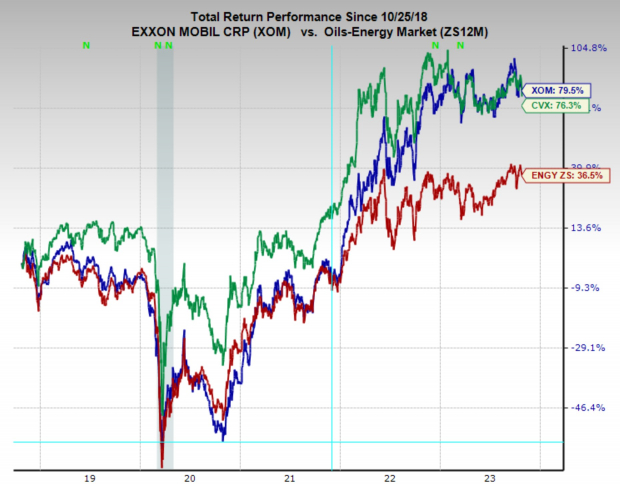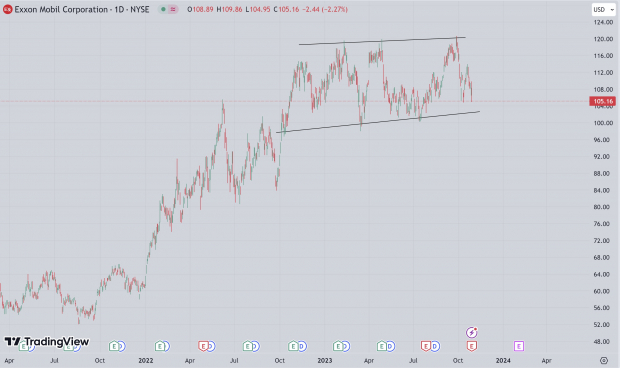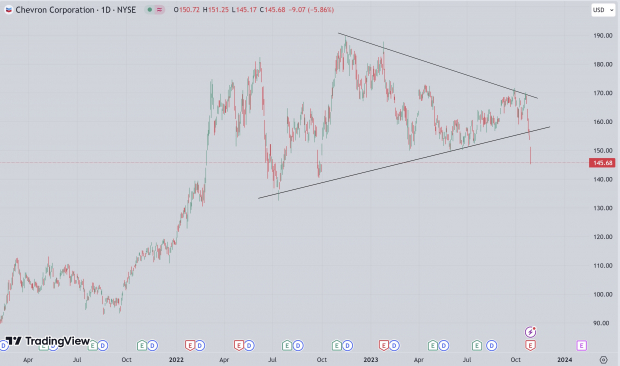A Bet On Long-Term Oil Demand: Chevron And Exxon Mobil Commence Dealmaking Arms Race

Image: Bigstock
Exxon Mobil (XOM - Free Report) and Chevron (CVX - Free Report) reported quarterly earnings on Friday morning, and both companies missed quarterly earnings expectations. The energy giants saw EPS drop more than -40% year-over-year, in stark contrast to last year’s banner performance.
Both stocks were seen selling off following the report, with Exxon Mobil down -2.3% midday and Chevron down -6%. However, amid the earnings miss and stock weakness, there were still some compelling highlights. Chevron has returned a record $20 billion of cash to shareholders year-to-date, while Exxon Mobil returned $8.1 billion in just the third quarter and raised the dividend to $0.95 per share.
Massive Deals Closed This Month
Also happening in the background, the energy supermajors Exxon Mobil and Chevron have further consolidated the oil market through some of the largest deals in industry history this past month. Exxon Mobil acquired Pioneer Natural Resources (PXD - Free Report) for $59.5 billion earlier this month, while Chevron bought Hess (HES - Free Report) for $53 billion this past week.
Exxon’s acquisition of Pioneer Natural Resources will significantly boost its exposure to the Permian Basin, which is the largest oil reserve in the US. Chevron’s purchase of Hess now gives the energy producer significant exposure to Guyana, which is the newest booming offshore oilfield. Since 2015, some 30 new discoveries have been made offshore, turning the South American country of 800,000 people into a new major player in the oil market.
Exxon Mobil already had a 45% stake in the reserves, but this acquisition of Hess, which has a 30% stake, gives Chevron a major foothold.
These acquisitions by energy giants stand in stark contrast with International Energy Agency (IEA) expectations for future oil consumption. The oil authority recently released a report finding that oil demand will peak by 2023, but oil companies think differently.
In an interview with the Financial Times, Chevron’s CEO Mike Wirth criticized the IEA saying “I don’t think they are remotely right... You can build scenarios, but we live in the real world, and have to allocate capital to meet real-world demands.”
Stock Performance
So, with all these developments in the oil stocks, which one should investors pick; Exxon Mobil or Chevron? Let’s take a look.
Over the last five years, both stocks have performed almost in lock step, beating the sector's returns and just slightly edging out the broad market over that period. But if you go back a bit further, Chevron has outperformed Exxon Mobil by a significant margin.
Over the last 20 years, Chevron has compounded at an annual rate of 11.4%, for a total of 795%, and Exxon has compounded at 9%, for a total return of 473%. Should we expect this outperformance to continue, or could it flip going forward?

Image Source: Zacks Investment Research
Technical Divergence
After Friday's mostly disappointing report, both stocks were seen selling off, but one looked much more conducive to higher prices than the other.
The chart below is the price action of Exxon Mobil. We can see that the stock has been carving out a wide consolidation throughout this year, and following the bad news, it was trading lower while still holding the lower bound of support.

Image Source: TradingView
Conversely, Chevron has been staging a major breakdown from the very large pennant pattern. This technical divergence is, in my opinion, indicative of investors' expectations for the stocks.

Image Source: TradingView
Free Cash Flow Yield
The two stocks have nearly identical earnings multiples, with XOM recently trading at a one-year forward multiple of 11.5x, and CVX recently trading at 11.3x, which has been the case for many years.
However, when looking at the Free Cash Flow Yield, one is clearly better than the other. When looking at stocks, I often like to look at the FCF yield as it gives a significant look into how much cash is being produced by the companies in question.
With an FCF Yield of 11.8%, Exxon Mobil has a 260-basis point lead on CVX’s 9.2% yield. Now each of these are quite impressive, but the higher yield from XOM is undeniably more appealing.

Image Source: Zacks Investment Research
Bottom Line
While the competition between Exxon and Chevron will continue to wage on, one thing appears certain. European energy producers are likely being hampered by the increasing pressures from their local authorities, whose push for a clean energy transition is far more aggressive than American counterparts. Because of this, I think we can assume that American energy companies should experience superior returns to their European counterparts, thanks to the fewer constraints.
But between Chevron and Exxon Mobil, which stock is the winner? I lean towards Exxon Mobil because its business is a bit more diversified than Chevron’s, it has a higher Free Cash Flow yield, minimizing downside, and it has clearly experienced a better response to the poor earnings report.
However, it should be noted that these two businesses are far more similar than they are different, so regardless of which one investors prefer, both are likely to remain long-term winners.
More By This Author:
Top Consumer Staples Aristocrats To Buy Amid Recent Market Volatility3 Key Quarterly Releases To Watch Next Week - Saturday, Oct. 28
These 3 Top-Ranked Companies Boast Robust Sales Growth
Disclosure: Zacks.com contains statements and statistics that have been obtained from sources believed to be reliable but are not guaranteed as to accuracy or completeness. References to any specific ...
more


